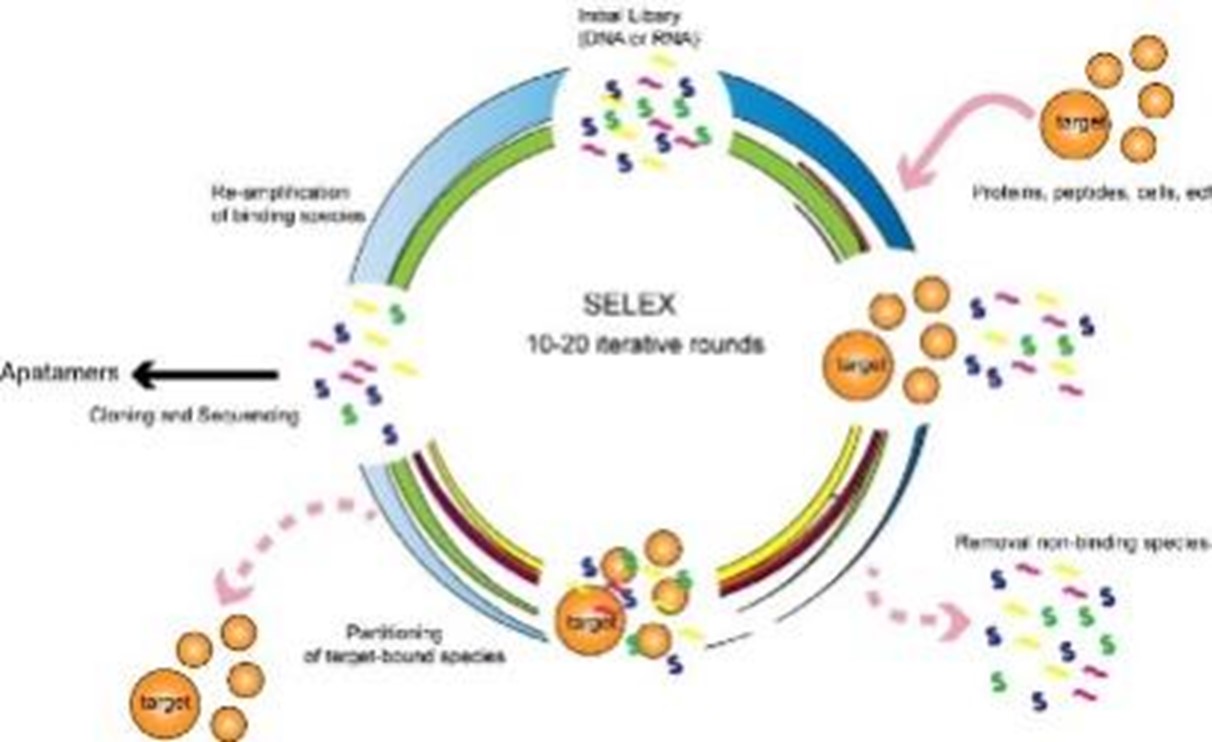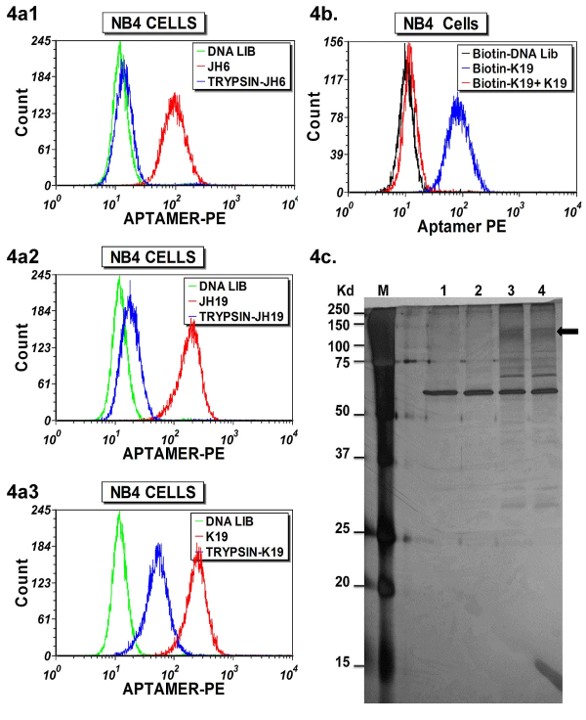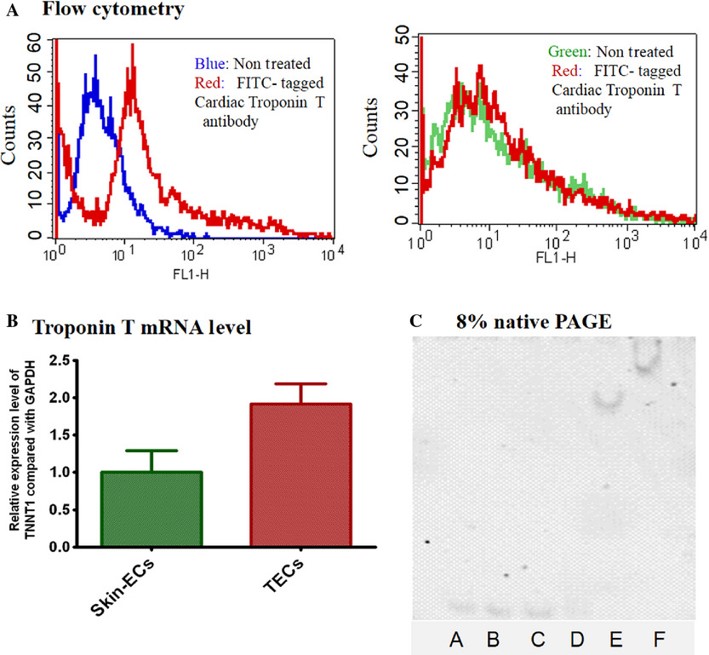Biomarkers are signature molecules that can indicate specific physiological states of cells. Identification of reliable biomarkers is important for early diagnosis and adaptive treatment of diseases. Diagnostic aptamers, therapeutic aptamers aptamers as well as aptamers in biomarker discovery have shown promise. Using complex samples as targets and improved SELEX methods, a panel of aptamers can be systematically generated by Creative Biolabs for comprehensive recognition of biomarkers. Based on years of professional experience, Creative Biolabs is competent to provide high-quality aptamer-based biomarker discovery services for global researchers.
Traditional Biomarker Discovery Methods
The discovery and identification of biomarkers promote the rational and fast development of medical diagnosis and therapeutics. Conventional approaches for biomarker discovery mainly involve genomics and proteomics. However, gene expression does not always correlate with the abundance and the variation of encoded proteins, which are often subject to post-translational modification (PTM) or proteolytic cleavage. Proteomic methods, which focus on characterizing the expression and alteration of proteins, are more straightforward for interpreting the cellular phenotype. By combining mass spectrometry (MS) with two-dimensional gel electrophoresis (2D-GE), some progress has been made in proteome analysis and specific protein identification. However, these technologies tend to provide false-positive results originating from intensive sample processing, including cell/tissue lysis, isolation, and purification.
Another classical method for biomarker discovery has been the incorporation of antibodies. Antibody-based strategies often require a sandwich system for screening target proteins. This means that two antibodies must be able to properly identify the target, making large-scale biomarker screening impractical under these conditions. Moreover, the systematic production of antibody libraries for molecular differentiation of cancer cells is very difficult.
Aptamer-based Biomarker Discovery
At present, different aptamer-based screening technologies have been developed to facilitate biomarker discovery. SOMAS can technology is an unbiased biomarker detection method that can analyze numerous and even thousands of proteins in complex biological samples at the same time. Cell-SELEX technology is mainly used to identify cell membrane surface biomarkers of various cells.
A promising detection platform that can quantify the expression levels of a variety of proteins will deliver valuable information concerning disease diagnosis. Aptamers can distinguish among thousands of proteins and do so in a short period, and they can detect small differences between proteins that are quite similar in structure. Multiplexed systems that incorporate aptamers for a variety of proteins can be performed, and the aptamers that do bind to protein can be quantified via microarray analysis to determine the ratio of specific proteins.
 Fig.1 SELEX.1, 2
Fig.1 SELEX.1, 2
Aptamer-based biomarkers discovery broadens the road and increases the sensitivity to explore novel biomarkers. Aptamers can not only provide a way of discovering biomarkers that help to differentiate between normal cells and cancer cells, but they can also help to differentiate the stage of carcinogenesis within one subtype of cancer. Besides, it is worth noting that single biomarkers are difficult to diagnose disease and clarify mechanisms. Thus, biomarker panels should be highly suggested and combining with clinical indicators to improve the predictive power of diseases.
Custom Aptamer Discovery Services
Traditional biomarker discovery is a long process and relies on multiple comparisons using various analytical techniques. The unique process of advanced aptamer selection offers exciting opportunities for biomarker discovery, while aptamer selectivity and stability make them ideal reagents for biomarker assay development. Cell-SELEX is an exciting technique that enables the selection of aptamers without prior identification of a specific cell surface target. The selection of aptamer affinity reagents to cells or unknown targets of interest is used to identify new disease-specific targets for therapeutic development and early-stage diagnostics. Combining traditional SELEX with cell-SELEX helps ensure selectivity for cell surface targets in their native form.
Creative Biolabs has performed several cell-SELEX projects, including the selection of aptamers to cell-surface markers and the identification of aptamers that enter specific cells. If you are interested in our biomarker discovery services, please feel free to contact us for more information.
Published Data
1. Aptamer-Based Acute Myelogenous Leukemia Detection and Biomarker Discovery
 Fig.2 The biotin-labeled aptamer for capturing and concentrating its target protein.3
Fig.2 The biotin-labeled aptamer for capturing and concentrating its target protein.3
This study presented a method for developing single-stranded DNA aptamer probes, phenotyping acute myelogenous leukemia (AML) cells in clinical samples, and identifying the target protein recognized by the aptamer. The NB4 AML cell line was used to select aptamers, which were then tested for their affinity to leukocytes. These aptamers were employed to characterize human bone marrow leukocytes and AML cells in clinical specimens. A biotin-labeled aptamer was employed to capture and identify its target protein. Three novel aptamers were identified, each selectively binding to myeloid cells with high affinity in the low nanomolar range (Kd between 2.77 and 12.37 nM). One aptamer’s target, identified as Siglec-5, is a surface protein with low abundance that serves as a biomarker for granulocytic maturation and can phenotype AML. Notably, Siglec-5 expression could identify low levels of AML cells and act as a potential leukemic therapeutic target.
2. Developing Aptamer for Identification of Troponin T as a Novel Tumor Endothelial Cell Surface Marker
 Fig.3 The confirmation of troponin T as the target protein of the aptamer.4
Fig.3 The confirmation of troponin T as the target protein of the aptamer.4
This study reported the discovery of a novel biomarker on primary cultured mouse tumor endothelial cells (mTECs) through a high-affinity DNA aptamer-based proteomics approach. Researchers employed an aptamer-facilitated biomarker discovery strategy, incubating biotin-tagged aptamers with mTEC lysates. The aptamer-protein complexes were then captured using streptavidin magnetic beads and separated by SDS-PAGE with silver staining. The MALDI-TOF mass spectrometry identified troponin T as the molecular target of the aptamer. Its presence was validated through mRNA, protein analysis, western blot, immunostaining, and a gel shift assay. This study is the first to report troponin T on mTECs, offering a potential diagnostic tool for antiangiogenic therapy targeting tumor vasculature.
References
- Zhuo, Zhenjian, et al. "Recent advances in SELEX technology and aptamer applications in biomedicine." International journal of molecular sciences 18.10 (2017): 2142.
- Distributed under Open Access license CC BY 4.0, without modification.
- Yang, Mingli, et al. "Developing aptamer probes for acute myelogenous leukemia detection and surface protein biomarker discovery." Journal of hematology & oncology 7 (2014): 1-14. Distributed under Open Access license CC BY 2.0, without modification.
- Ara, Mst Naznin, et al. "Identification and expression of troponin T, a new marker on the surface of cultured tumor endothelial cells by aptamer ligand." Cancer medicine 3.4 (2014): 825-834. Distributed under Open Access license CC BY 3.0, without modification.
For Research Use Only.

